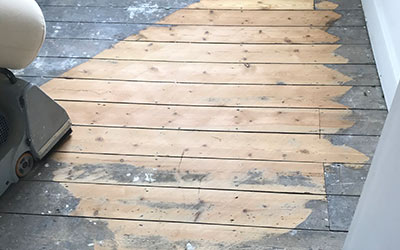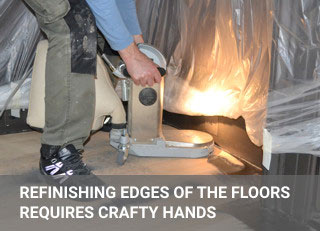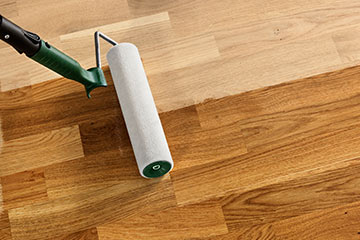Back to Floor Sanding
How to Sand Floorboards Like a Pro

If you're looking to renovate your house, sanding floorboards can be a great way to achieve a fresh look. Heavily stained floorboards can be stripped back and treated in a way that complements your new design scheme while retaining their natural charm.
Although it can be a rewarding process, it’s important to be prepared for the noise, dust, and effort involved. If you're on a budget, hiring a sander is often not overly expensive, making it a cost-effective way to trade off some hard work for a stunning timber floor.
Key Takeaways:
- Sanding enhances the appearance of your floorboards.
- Be prepared for the clean-up involved in the process.
- Hiring equipment can be budget-friendly.
When is Sanding Floorboards Necessary?
Sanding floorboards is an effective way to improve the look of your floors and remove unsightly blemishes. In some cases, you may only need to spot sand specific areas to eliminate stains or scratches. However, if your goal is to strip back the floorboards or remove a stain across the entire floor, then more intensive sanding will be required.
Key Considerations for Sanding:
- Surface Imperfections: Minor scratches or blemishes may only need spot sanding.
- Full Restoration: Extensive stains or wear may require sanding the entire surface.
- Desired Finish: Consider the final appearance you wish to achieve before deciding on the sanding method.
Can you Sand Floorboards by Hand?
Sanding floorboards by hand can be a labour-intensive process, but it is certainly possible if you're willing to put in the effort. Follow these steps for effective hand sanding:
- Prepare the Area: Remove any debris or loose material from the surface of the floorboards using a broom or vacuum cleaner. This ensures a smooth sanding process.
- Coarse Sanding: Start with coarse sandpaper to sand the surface of the floorboards, working in small sections. This helps to remove the top layer and any significant imperfections.
- Fine Sanding: Once you’ve finished sanding with the coarse sandpaper, switch to finer grit sandpaper and repeat the process. This will help smooth out the surface and prepare it for finishing.
- Clean Up: Finally, use a clean cloth to remove any dust or debris from the surface of the floorboards. This step is crucial for achieving a polished finish.
Note: While sanding by hand can be effective for small areas or touch-ups, for larger spaces, consider using a floor sander for quicker and more uniform results.
What Kind of Sander Should I use to Sand Floorboards?
Hiring a professional to sand your floorboards can be expensive, so it's essential to know what kind of sander to use. Here are the most suitable options:
- Drum Sander:
- Best for sanding floorboards. It is a heavy-duty sander that can effectively strip and smooth large areas.
- Make sure to choose the right size machine for your project and use the appropriate type of sandpaper.
- Edge Sander:
- This smaller handheld sander is perfect for finishing off the edges of the floor and reaching areas the drum sander cannot access.
- It complements the drum sander and helps ensure a uniform finish.
- Mouse Sander or Orbital Sander:
- These can also be helpful for intricate details and small spaces where precision is required.
Important Considerations:
- Be aware of the potential hazards of sanding floorboards, such as creating excessive dust or causing damage to the boards.
- Always start with coarse-grit sandpaper and gradually work your way up to finer grit. This approach helps to avoid damaging the wood.
- If you're unsure which type of sandpaper to use, consult a professional at the store where you're renting the sander for guidance.
How do I Sand Floorboards?
Prepare your floor for sanding

The first step in sanding your floor is to evaluate the existing floor. Here’s how to prepare:
- Check for Levelness:
- Ensure that the floorboards are level. Any uneven areas can lead to issues during sanding.
- Inspect for Protruding Nails:
- Look for any nails that may be sticking out of the floorboards. These can snag the sanding paper and cause damage.
- Use a Nail Punch:
- Use a nail punch and a hammer to gently drive all nails below the surface of the floor. This will create a smooth surface for sanding.
- Repair Uneven Areas:
- If there are any uneven spots, repair the wood floor to level it out before you begin sanding.
Once you’ve completed these essential preparation steps, you’re ready to start sanding your floor!
Sand the floorboards with the drum sander
After sanding the floorboards with the drum sander, follow these steps to ensure a smooth and level finish:
- Start Diagonally:
- If the floorboards are not perfectly level, begin by sanding across the room diagonally. This technique will help level them out.
- Sand with the Grain:
- Once leveled, sand back and forth following the grain of the wood. This will minimize scratches and provide a more polished look.
- Work Near Walls:
- Go as close to the wall as possible, leaving just the edges to be finished with the edge sander.
- Read the Manual:
- If you're using a rented sander, be sure to review the manual before you begin. Understanding how to operate the machine properly is crucial to avoid any damage to the floorboards.
- Wear Protective Gear:
- Sanding can be a dusty process, so always wear a dust mask and keep windows open for ventilation.
- Select the Right Sandpaper Grit:
- Start by selecting the appropriate sandpaper grit based on the condition of your floorboards:
- For heavily stained or damaged boards, begin with 16 or 24-grit sandpaper.
- Gradually progress to finer grits, such as 40 or 60 grit, and finish with 80 or 100 grit for a smooth surface.
- Remember, lower numbers indicate coarser sandpaper, while higher numbers indicate finer sandpaper.
- Regular Vacuuming:
- Vacuum regularly during the sanding process to keep the area clean and to see any remaining stains on the floorboards. It can get quite dusty!
By following these steps, you'll be on your way to achieving beautifully sanded floorboards!
Sand the edges with the edge sander
To achieve a polished finish, use the edge sander following the same progression of sandpapers as you did with the drum sander. Here are some steps to follow:
- Progression of Sandpaper:
- Use one grit at a time, completely sanding the entire room with that grit before moving on to the next. This will help you maintain consistency.
- Observe Color Changes:
- As you sand, you’ll notice the floor gradually becoming a uniform colour as more of the stain or dirt is removed.
- Tackle Tight Corners:
- For tight corners where the edge sander may not reach, consider using a mouse sander. These are often available for hire, or you can purchase an inexpensive corded model from your local DIY store.
- Consistency is Key:
- Ensure that you apply consistent pressure and movement to avoid creating uneven areas.
By carefully sanding the edges, you'll achieve a seamless transition from the edges to the centre of the floor, enhancing the overall appearance of your newly sanded floorboards.
How Many Sandpaper Sheets Will I Need for Sanding Floorboards?
The amount of sandpaper required will vary depending on the size of your room. As a general guideline, for a 3m x 4m room, you can expect to use:
- 6 to 7 sheets of the roughest grit (16 or 24 grit).
- 2 to 3 sheets of the finest grit (80 to 100 grit).
This applies similarly to the edge sander as well. Keep in mind that you'll typically need fewer sheets as you progress to finer sandpaper.
It's also important to note that many hire companies will refund you for any unused sandpaper sheets, so don’t hesitate to purchase extra. Running out of sandpaper can waste valuable time during your rental period. Additionally, having a few extra sheets on hand can be beneficial in case you encounter tears from nails or other unforeseen issues.
How Long Does it Take to Sand Floorboards?
Sanding floorboards can be a time-consuming task, but the results are well worth the effort. To ensure a smooth process, make sure you are well prepared before you start by reading the instructions and practising with the equipment.
Expect the sanding process to take approximately 2 to 3 days for a medium-sized room. This timeline includes preparation, actual sanding, and any necessary touch-ups. It’s crucial to take regular breaks to avoid fatigue and maintain your focus. Additionally, always sand in a well-ventilated area to minimize dust accumulation and ensure your safety.
What is the Best way to Finish Floorboards?

After sanding your floorboards, choosing the right finish is crucial for achieving the desired look and durability. The best option for you will depend on your specific needs and preferences. Here are some common finishing options, along with their characteristics:
- Varnishes:
- Durability: Great for producing durable floors that require less maintenance.
- Stain Resistance: Less likely to stain.
- Reapplication: When recoating is necessary, you will likely need to sand the floorboards again.
- Stains:
- Provide colour and enhance the wood grain.
- Often need a protective topcoat to seal and protect the wood.
- Waxes:
- Offer a natural, soft finish.
- Require regular maintenance and reapplication to keep the floor protected.
- Sealants:
- Provide a strong barrier against moisture and wear.
- Typically have a more plastic-like finish compared to oils or waxes.
- Hard Wax Oil:
- A popular choice for its balance of durability and aesthetics.
- Contains a small amount of wax, enhancing its durability.
- Allows for maintenance and reapplication in high-traffic areas without the need to re-sand the entire floor.
When selecting a finish, consider the level of maintenance you're willing to commit to and the specific needs of your space. Each option has its benefits and drawbacks, so make sure to choose wisely for the best long-term results.